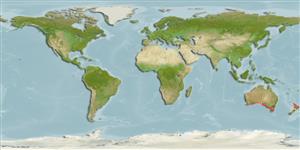Common names from other countries
分类 / Names
俗名 | 同种异名 | Catalog of Fishes(属, 种) | ITIS | CoL | WoRMS | Cloffa
Elasmobranchii
板鳃亚纲 (鲨鱼与 鱼) (sharks and rays) >
Carcharhiniformes (Ground sharks)
白眼鮫目 (Ground sharks) >
Scyliorhinidae (Cat sharks)
貓鮫科(Cat sharks) (Cat sharks) > Scyliorhininae
Etymology: Cephaloscyllium: cephalus, from kephale (Gr.), head, referring to its very broad and depressed head; skylion, Greek for dogfish or small shark. (See ETYFish); laticeps: latus (L.), wide or broad; ceps (New Latin), head, referring to its broad, parabola-shaped head. (See ETYFish).
More on author: Duméril.
Environment: milieu / climate zone / depth range / distribution range
生态学
海洋 居于水底的; 深度上下限 1 - 220 m. 亞熱帶的; 32°S - 44°S
Eastern Indian Ocean: southern Australia, from Western Australia to New South Wales.
東印度洋: 澳洲南部, 從澳洲西部到新南威爾斯。
Length at first maturity / 大小 / 重量 / 年龄
Maturity: Lm ?, range 82 - ? cm
Max length : 150 cm TL 雄鱼/尚未辨别雌雄; (Ref. 6871)
简单描述
检索表 | 型态特徵 | 形态测量图
脊椎骨: 129 - 138. Head short and very broad. Body robust with inflatable stomach; with dark, mottled and blotched color pattern, and mostly with a dark median stripe on the belly. Labial furrows absent. Denticles large and widely spaced.
头部短与非常宽的。 身体结实的具有膨胀的腹部; 有深色的, 有斑点的而且大斑点彩色斑纹, 而且大部份在腹面上具有一个黑的中央斑纹。 唇沟不存在。 细齿大与空隙大的。
Found on the continental shelf from close inshore in shallow to deeper water. Oviparous, hatching at about 14 cm (Ref. 6871). Can expand itself with air or water. Caught by commercial bottom trawlers but of no use to fisheries at present.
在浅水区到较深的水域中栖息于大陆架从岸边了。 被于大约 14 公分孵化的卵生的.(参考文献 6871) 能以空气或水使自己膨胀。 被商业性底拖网捕获了但是目前对渔民没有用处。
Life cycle and mating behavior
Maturities | 繁殖 | Spawnings | Egg(s) | Fecundities | 仔鱼
Oviparous, paired eggs are laid. Embryos feed solely on yolk (Ref. 50449).東印度洋: 澳洲南部, 從澳洲西部到新南威爾斯。
Compagno, L.J.V., 1984. FAO Species Catalogue. Vol. 4. Sharks of the world. An annotated and illustrated catalogue of shark species known to date. Part 2 - Carcharhiniformes. FAO Fish. Synop. 125(4/2):251-655. Rome: FAO. (Ref. 244)
CITES (Ref. 128078)
Not Evaluated
人类利用
渔业: 没有兴趣
工具
特别资料
下载 XML
网络资源
Estimates based on models
Preferred temperature (Ref.
115969): 14 - 18.2, mean 16 (based on 175 cells).
Phylogenetic diversity index (Ref.
82804): PD
50 = 0.5000 [Uniqueness, from 0.5 = low to 2.0 = high].
Bayesian length-weight: a=0.00263 (0.00139 - 0.00497), b=3.21 (3.04 - 3.38), in cm Total Length, based on LWR estimates for this (Sub)family-body shape (Ref.
93245).
营养阶层 (Ref.
69278): 4.3 ±0.5 se; based on size and trophs of closest relatives
回复力 (Ref.
120179): 低的, 最小族群倍增时间4.5 - 14 年 (Fec assumed to be <100).
Fishing Vulnerability (Ref.
59153): Very high vulnerability (90 of 100).
